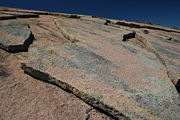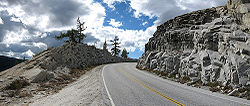
Exfoliation (geology)
Encyclopedia

General characteristics of exfoliation joints
- Commonly follow topographyTopographyTopography is the study of Earth's surface shape and features or those ofplanets, moons, and asteroids...
(Gilbert, 1904; Matthes, 1930; Goodman, 1993). - Divide the rockRock (geology)In geology, rock or stone is a naturally occurring solid aggregate of minerals and/or mineraloids.The Earth's outer solid layer, the lithosphere, is made of rock. In general rocks are of three types, namely, igneous, sedimentary, and metamorphic...
into sub-planar slabs (Goodman, 1993). - Joint spacing increases with depth from a few centimeters near the surface to a few meters (Dale, 1923; Jahns, 1943; Goodman, 1993).
- Maximum depth of observed occurrence is around 100 meters (Dale, 1923; Jahns, 1943; Holzhausen, 1989; Goodman, 1993).
- Deeper joints have a larger radius of curvature, which tends to round the corners of the landscapeLandscapeLandscape comprises the visible features of an area of land, including the physical elements of landforms such as mountains, hills, water bodies such as rivers, lakes, ponds and the sea, living elements of land cover including indigenous vegetation, human elements including different forms of...
as material is eroded (Gilbert, 1904; Dale, 1923; Matthes, 1930; Jahns, 1943; Goodman, 1993). - FractureFracture mechanicsFracture mechanics is the field of mechanics concerned with the study of the propagation of cracks in materials. It uses methods of analytical solid mechanics to calculate the driving force on a crack and those of experimental solid mechanics to characterize the material's resistance to fracture.In...
mode is tensile (Bahat et al., 1999; Mandl, 2005). - Occur in many different lithologiesPetrologyPetrology is the branch of geology that studies rocks, and the conditions in which rocks form....
and climate zones, not unique to glaciated landscapes (Bradley 1963; Twidale, 1973; Goodman, 1993). - Host rock is generally sparsely jointed, fairly isotropic, and has high compressive strengthCompressive strengthCompressive strength is the capacity of a material or structure to withstand axially directed pushing forces. When the limit of compressive strength is reached, materials are crushed. Concrete can be made to have high compressive strength, e.g...
(Gilbert, 1904; Jahns, 1943; Twidale, 1973). - Can have concave and convex upwards curvatures (Gilbert, 1904; Matthes, 1930; Romani and Twidale, 1999).
- Often associated with secondary compressive forms such as arching, bucklingBucklingIn science, buckling is a mathematical instability, leading to a failure mode.Theoretically, buckling is caused by a bifurcation in the solution to the equations of static equilibrium...
, and A-tents (buckled slabs) (Romani and Twidale, 1999).
Formation of exfoliation joints
Despite their common occurrence in many different landscapes, geologists have yet to reach an agreement on a general theory of exfoliation joint formation. Many different theories have been suggested, below is a short overview of the most common.Removal of overburden and rebound

Grove Karl Gilbert
Grove Karl Gilbert , known by the abbreviated name G. K. Gilbert in academic literature, was an American geologist....
in 1904 and is widely found in introductory geology texts. The basis of this theory is that erosion
Erosion
Erosion is when materials are removed from the surface and changed into something else. It only works by hydraulic actions and transport of solids in the natural environment, and leads to the deposition of these materials elsewhere...
of overburden
Overburden
Overburden is the material that lies above an area of economic or scientific interest in mining and archaeology; most commonly the rock, soil, and ecosystem that lies above a coal seam or ore body. It is also known as 'waste' or 'spoil'...
and exhumation of deeply buried rock to the ground surface allows previously compressed rock to expand radially, creating tensile stress and fracturing the rock in layers parallel to the ground surface. The description of this mechanism has led to alternate terms for exfoliation joints, including pressure release or offloading joints. Though the logic of this theory is appealing, there are many inconsistencies with field and laboratory observations suggesting that it may be incomplete, such as (Wolters, 1969; Twidale, 1973; Holzhausen, 1989):
- Exfoliation joints can be found in rocks that have never been deeply buried.
- Laboratory studies show that simple compression and relaxation of rock samples under realistic conditions does not cause fracturing.
- Exfoliation joints are most commonly found in regions of surface-parallel compressive stressStress (physics)In continuum mechanics, stress is a measure of the internal forces acting within a deformable body. Quantitatively, it is a measure of the average force per unit area of a surface within the body on which internal forces act. These internal forces are a reaction to external forces applied on the body...
, whereas this theory calls for them to occur in zones of extension.
One possible extension of this theory to match with the compressive stress theory (outlined below) is as follows (Goodman, 1989; 1993): The exhumation of deeply buried rocks relieves vertical stress
Stress (physics)
In continuum mechanics, stress is a measure of the internal forces acting within a deformable body. Quantitatively, it is a measure of the average force per unit area of a surface within the body on which internal forces act. These internal forces are a reaction to external forces applied on the body...
, but horizontal stresses can remain in a competent rock mass since the medium is laterally confined. Horizontal stresses become aligned with the current ground surface as the vertical stress drops to zero at this boundary. Thus large surface-parallel compressive stresses can be generated through exhumation that may lead to tensile rock fracture as described below.
Thermoelastic strain
Rock expands upon heating and contracts upon cooling and different rock-forming minerals have variable rates of thermal expansionThermal expansion
Thermal expansion is the tendency of matter to change in volume in response to a change in temperature.When a substance is heated, its particles begin moving more and thus usually maintain a greater average separation. Materials which contract with increasing temperature are rare; this effect is...
/ contraction. Daily rock surface temperature variations can be quite large, and many have suggested that stresses created during heating cause the near-surface zone of rock to expand and detach in thin slabs (e.g. Wolters, 1969). Large diurnal
Diurnal temperature variation
Diurnal temperature variation is a meteorological term that relates to the variation in temperature that occurs from the highs of the day to the cool of nights.-Temperature lag:Temperature lag is an important factor in diurnal temperature variation...
or fire-induced temperature fluctuations have been observed to create thin lamination and flaking at the surface of rocks, sometimes labeled exfoliation (Blackwelder, 1927). However, since diurnal temperature fluctuations only reach a few centimeters depth in rock (due to rock’s low thermal conductivity
Thermal conductivity
In physics, thermal conductivity, k, is the property of a material's ability to conduct heat. It appears primarily in Fourier's Law for heat conduction....
), this theory cannot account for the observed depth of exfoliation jointing that may reach 100 meters (Gilbert, 1904; Twidale, 1973; Holzhausen, 1989; Goodman, 1993).
Chemical weathering
Mineral weatheringWeathering
Weathering is the breaking down of rocks, soils and minerals as well as artificial materials through contact with the Earth's atmosphere, biota and waters...
by penetrating water can cause flaking of thin shells of rock since the volume of some minerals increases upon hydration
Mineral hydration
Mineral hydration is an inorganic chemical reaction where water is added to the crystal structure of a mineral, usually creating a new mineral, usually called a hydrate....
(Twidale, 1973). However, not all mineral hydration results in increased volume, while field observations of exfoliation joints show that the joint surfaces have not experienced significant chemical alteration, so this theory can be rejected for explaining the origin of large-scale, deeper exfoliation joints described in this article.
Compressive stress and extensional fracture
Large compressive stressesStress (physics)
In continuum mechanics, stress is a measure of the internal forces acting within a deformable body. Quantitatively, it is a measure of the average force per unit area of a surface within the body on which internal forces act. These internal forces are a reaction to external forces applied on the body...
parallel to the land (or a free) surface can create tensile mode fractures
Fracture mechanics
Fracture mechanics is the field of mechanics concerned with the study of the propagation of cracks in materials. It uses methods of analytical solid mechanics to calculate the driving force on a crack and those of experimental solid mechanics to characterize the material's resistance to fracture.In...
in rock, where the direction of fracture propagation is parallel to the greatest principle compressive stress and the direction of fracture opening is perpendicular to the free surface (Bradley, 1963; Brunner and Scheidegger, 1973; Twidale, 1973; Holzhausen, 1989; Goodman, 1993; Bahat, 1999; Mandl, 2005). This type of fracturing has been observed in the laboratory since at least 1900 (in both uniaxial and biaxial unconfined compressive loading; see Gramberg, 1989). Tensile cracks can form in a compressive stress field due to the influence of pervasive microcracks in the rock lattice and extension of so-called wing cracks from near the tips of preferentially oriented microcracks, which then curve and align with the direction of the principle compressive stress (Hoek and Bieniawski, 1965; Fairhurst and Cook, 1966). Fractures formed in this way are sometimes called axial cleavage, longitudinal splitting, or extensional fractures, and are commonly observed in the laboratory during uniaxial compression tests. High horizontal or surface-parallel compressive stress can result from regional tectonic or topographic stresses, or by erosion or excavation of overburden.
With consideration of the field evidence and observations of occurrence, fracture mode, and secondary forms, high surface-parallel compressive stresses and extensional fracturing (axial cleavage) seems to be the most plausible theory explaining the formation of exfoliation joints.
Engineering geology significance
Recognizing the presence of exfoliation joints can have important implications in geological engineering. Most notable may be their influence on slope stability. Exfoliation joints following the topography of inclined valley walls, bedrock hill slopes, and cliffs can create rock blocks that are particularly prone to sliding. Especially when the toe of the slope is undercut (naturally or by human activity), sliding along exfoliation joint planes is likely if the joint dip exceeds the joint’s frictional angle. Foundation work may also be affected by the presence of exfoliation joints, for example in the case of damsDAMS
Driot-Arnoux Motorsport is a racing team from France, involved in many areas of motorsports. DAMS was founded in 1988 by Jean-Paul Driot and former Formula One driver René Arnoux. It is headquartered near Le Mans, only 2 km from the Bugatti Circuit.- History :The year after its foundation,...
(Terzaghi, 1962). Exfoliation joints underlying a dam
Dam
A dam is a barrier that impounds water or underground streams. Dams generally serve the primary purpose of retaining water, while other structures such as floodgates or levees are used to manage or prevent water flow into specific land regions. Hydropower and pumped-storage hydroelectricity are...
foundation can create a significant leakage hazard
Hazard
A hazard is a situation that poses a level of threat to life, health, property, or environment. Most hazards are dormant or potential, with only a theoretical risk of harm; however, once a hazard becomes "active", it can create an emergency situation. A hazard does not exist when it is not...
, while increased water pressure in joints may result in lifting or sliding of the dam. Finally, exfoliation joints can exert strong directional control on groundwater
Groundwater
Groundwater is water located beneath the ground surface in soil pore spaces and in the fractures of rock formations. A unit of rock or an unconsolidated deposit is called an aquifer when it can yield a usable quantity of water. The depth at which soil pore spaces or fractures and voids in rock...
flow and contaminant transport.

